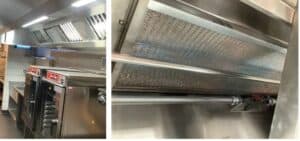By David Glover, Technical Director at Plasma Clean Air Ltd
In every commercial kitchen, from bustling restaurants to high-capacity catering facilities, one unsung hero quietly protects plumbing systems and the environment: the grease trap. These simple but essential devices play a vital role in capturing fats, oils, and grease (collectively known as FOG) before they enter the drainage system.
And while they might not be glamorous, routine servicing of grease traps is critical—not just to avoid blockages and foul odours, but to stay compliant with environmental regulations and avoid costly downtime.
What Is a Grease Trap and How Does It Work?
Grease traps—also referred to as grease interceptors—are plumbing devices fitted into wastewater drainage systems in commercial kitchens. Their job is straightforward: intercept FOG before it has a chance to harden and clog pipework and sewage system where it becomes a so-called ‘fatberg’.
Here’s how they do it:
- Wastewater from sinks, dishwashers, and cooking appliances flows into the grease trap.
- Inside the trap, the flow slows down, allowing the wastewater to cool.
- As this happens, lighter FOG floats to the top, while heavier food solids settle to the bottom.
- The cleaner water in the middle is then discharged to the sewer system.
It’s a deceptively simple process, but one that must function continuously and effectively to keep kitchen operations running smoothly.
Why Grease Traps Matter
1. Preventing Drain Blockages and Fatbergs
Without a grease trap—or with one that’s poorly maintained—FOG enters the drainage system, solidifies, and builds up over time. This leads to serious blockages that can cause foul smells, kitchen downtime, and expensive plumbing repairs. On a larger scale, it contributes to the formation of fatbergs—massive, solidified lumps of FOG and waste that clog public sewers and require costly intervention to remove.
2. Protecting the Environment
Grease traps are a first line of defence against environmental contamination. FOG that escapes into the drainage system can enter natural waterways, where it coats surfaces, affects wildlife, and disrupts ecosystems. By keeping grease traps in good working order, commercial kitchens help prevent such pollution.
3. Staying Compliant
Local authorities and water companies require commercial kitchens to install and maintain grease traps. Failure to do so can result in fines, enforcement notices, or even prosecution. In the UK, grease management is an increasingly visible part of environmental health inspections and wastewater discharge compliance.
Types of Grease Traps
There are two primary types of grease traps:
- Passive grease traps rely purely on gravity to separate FOG from wastewater. They’re simple and cost-effective but require more frequent manual cleaning.
- Automatic grease removal units (AGRUs) include mechanical components to skim and remove FOG. These systems reduce manual servicing and are often preferred in high-volume environments.
Routine Servicing: What’s Involved?
Grease traps don’t clean themselves, and neglecting them can quickly undo all their benefits. Servicing typically involves several key steps:
1. FOG Removal
- Vacuum extraction: Specialist vacuum trucks suck out accumulated FOG, water, and solids.
- Manual removal: Smaller traps may require manual scooping of FOG and debris.
2. Deep Cleaning
- All internal surfaces—including baffles and trap walls—are scraped and wiped clean.
- Food waste and silt that settles at the bottom are removed.
- Disinfection may be applied to external surfaces for hygiene and odour control.
- Components are inspected for damage or wear and replaced as needed.
3. Waste Disposal
- All waste must be taken to licensed disposal facilities, with waste transfer notes issued for traceability and compliance.
4. Functionality Testing
- After servicing, the trap is checked to ensure proper flow and that no blockages remain in surrounding pipework.
5. Preventative Maintenance
- Environmentally friendly products such as ‘fat busters’ or biological dosing agents may be introduced to help break down fats and control odours between cleans.
How Often Should a Grease Trap Be Serviced?
There’s no one-size-fits-all answer, but servicing frequency should match the level of kitchen activity:
- High-volume kitchens (e.g. busy restaurants, hotel kitchens): Weekly or fortnightly servicing may be required.
- Lower-volume operations (e.g. cafés, small catering units): Monthly or even quarterly cleaning might be sufficient.
A thorough assessment by a specialist is the best way to determine the right servicing interval for your business.
Key Considerations
Odour Control
FOG build-up leads to pungent, lingering odours that affect staff wellbeing and customer experience. Regular cleaning eliminates this problem, while additional measures like odour guards can provide further protection.
Blockage Prevention
Routine servicing is far more cost-effective than emergency plumbing work. Preventative maintenance saves time, money, and stress.
Regulatory Compliance
Documented servicing and waste disposal demonstrate your business’s commitment to hygiene and environmental protection—an increasingly important factor for customers, stakeholders, and regulators alike.
Book Expert Grease Trap Servicing Today
Grease traps may be out of sight, but they should never be out of mind. As the first line of defence against blocked drains, environmental damage, and compliance headaches, these systems are essential for any commercial kitchen. But they’re only as effective as the servicing they receive.
At Plasma Clean Air, we provide expert grease trap servicing tailored to your kitchen’s needs. Whether you operate a single restaurant or manage a multi-site food operation, we’ll help you stay compliant, odour-free, and blockage-free—with full traceability and peace of mind.
📞 Get in touch today to arrange a site assessment or schedule your next grease trap service.
🔗 www.plasma-clean.com | ✉️ [email protected] | ☎️ 0800 652 3325
Let’s keep your kitchen flowing smoothly.






